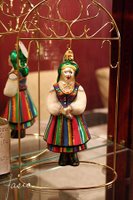It's easy to imagine what Christmas was like for my grandparents after they came to America. I've heard some stories, seen some movies, and read some books which together paint a picture for me of Christmas in the first half of the twentieth century in Detroit. The picture is in black and white by the way, like It's a Wonderful Life and Miracle on 34th Street. I even have some photos of my grandparents by their Christmas tree (in black and white of course).
I can smell all the goodies baking... my maternal grandparents owned a bakery so the yeasty smell of fresh-from-the-oven rye bread (their specialty), along with the rich scents of gooey cinnamon buns, thick and chewy gingerbread, and sparkling sugar cookies all play into my image of their Christmas. I've also heard my mother's stories about putting up the Christmas tree (a real pine of course) but not lighting it until Christmas Eve. No electric lights on the tree... candles only. And the tree was lit on Christmas Eve only for 30-60 minutes or so, the length of time it took for the candles to burn down. There were always buckets of water nearby just in case. Everyone would stand around and oooh and aaah the whole while, sing a couple of Polish Christmas carols, and feel the spiritual magic of Christmas.
My paternal grandparents didn't own a bakery so my image of their Christmases doesn't smell quite as good but they only lived a few blocks away from my maternal grandparents so I imagine their Christmas as otherwise very similar. Same Polish neighborhood, same Polish Wigilia dinner on Christmas Eve, same walk to midnight Mass at the nearby Catholic church.
If I go back to my paternal great grandparents' Christmas after they came to America things get a little more interesting. They came in 1881, before automobiles and before electric lighting. They had a stable in their back yard and no doubt went around town in a horse-drawn sleigh or wagon and used candles or lanterns to light their homes. It's a little more of a stretch to imagine this but photos and postcards from the period help a lot.
If I try to go back before these times to the Christmases of my earlier ancestors in Poland I draw a great big blank. I have no movies to rely on, no family stories, and until just recently, no books to read. Not only don't I read the Polish language but the peasantry in Poland were virtually all illiterate back in those days. They weren't able to write about their customs.
For years I have struggled trying to imagine the Christmases of my great grandparents in Poland but this year I finally have some insight. Thanks to The Peasants by Wladyslaw Reymont I now have a picture of Christmas in a peasant village in the 1800s in Poland. What's more, the villages mentioned in his book are about 30 miles from my maternal grandfather's village. So the customs, attire, architecture, and cuisine are likely to be essentially the same. This is a true treasure to me.
I haven't finished reading the book yet but I've read the sections on Autumn and Winter and I'm almost finished with Spring (it's a BIG book). I'll be sharing some of the Polish peasant Christmas in the days to come.
(Click to view larger image)
One thing that Poland is known for is it's glass making. A sub-specialty in that arena is their high quality glass Christmas ornaments. The high end lines of ornaments from Christopher Radko and Curtis Adler are all made in Poland as is this ornament of a Polish lady in her folk dress. This particular style of dress was from the Lowicz area of Poland (right near the setting for Reymont's novel). Considering that Poland is land-wise only about the size of the state of New Mexico, there are quite a variety of folk dress styles. This is one of my favorite ornaments and I keep it in my curio cabinet year round. It was purchased at a Polish import store in Detroit.
Technorati Tags:
